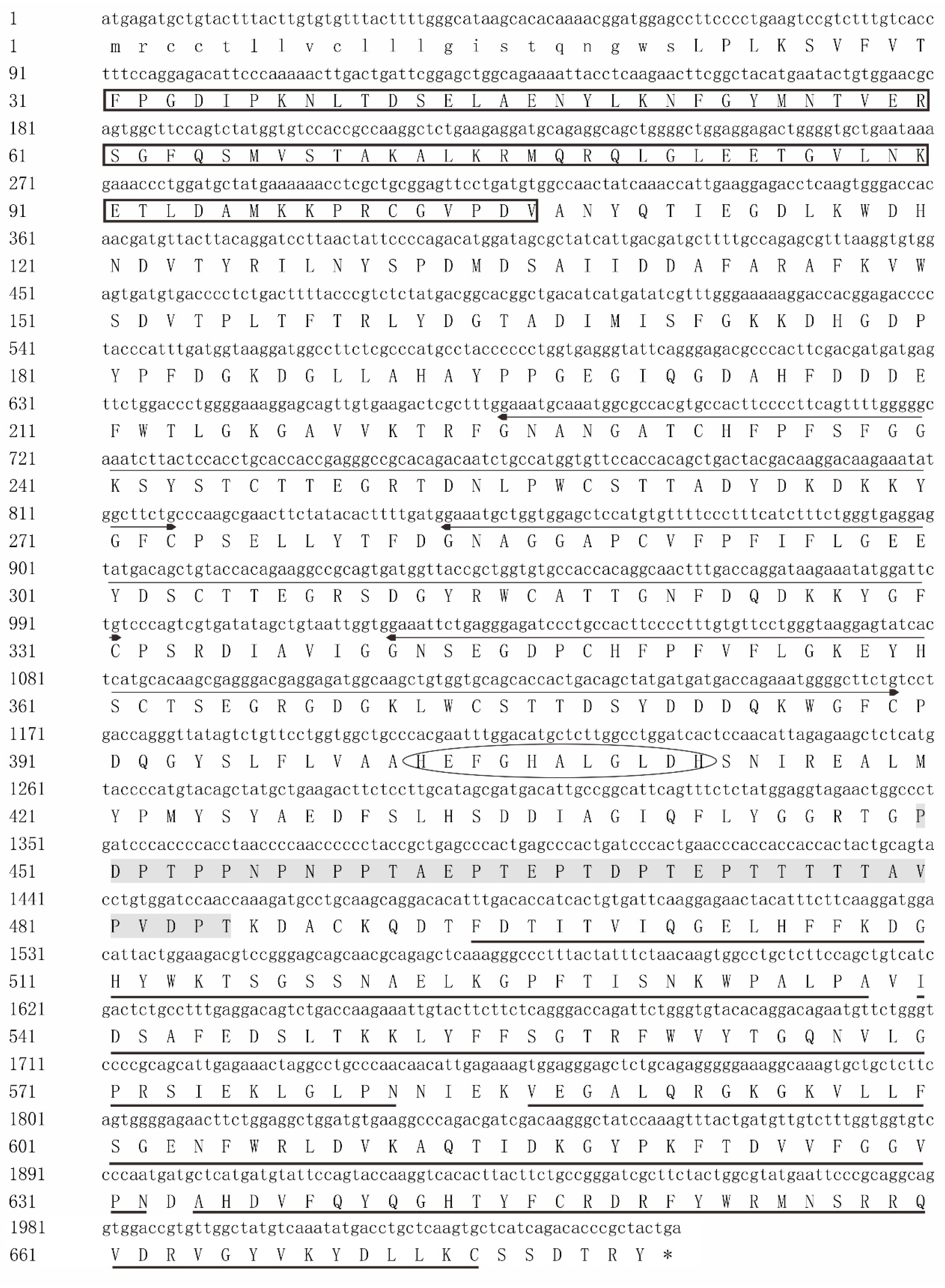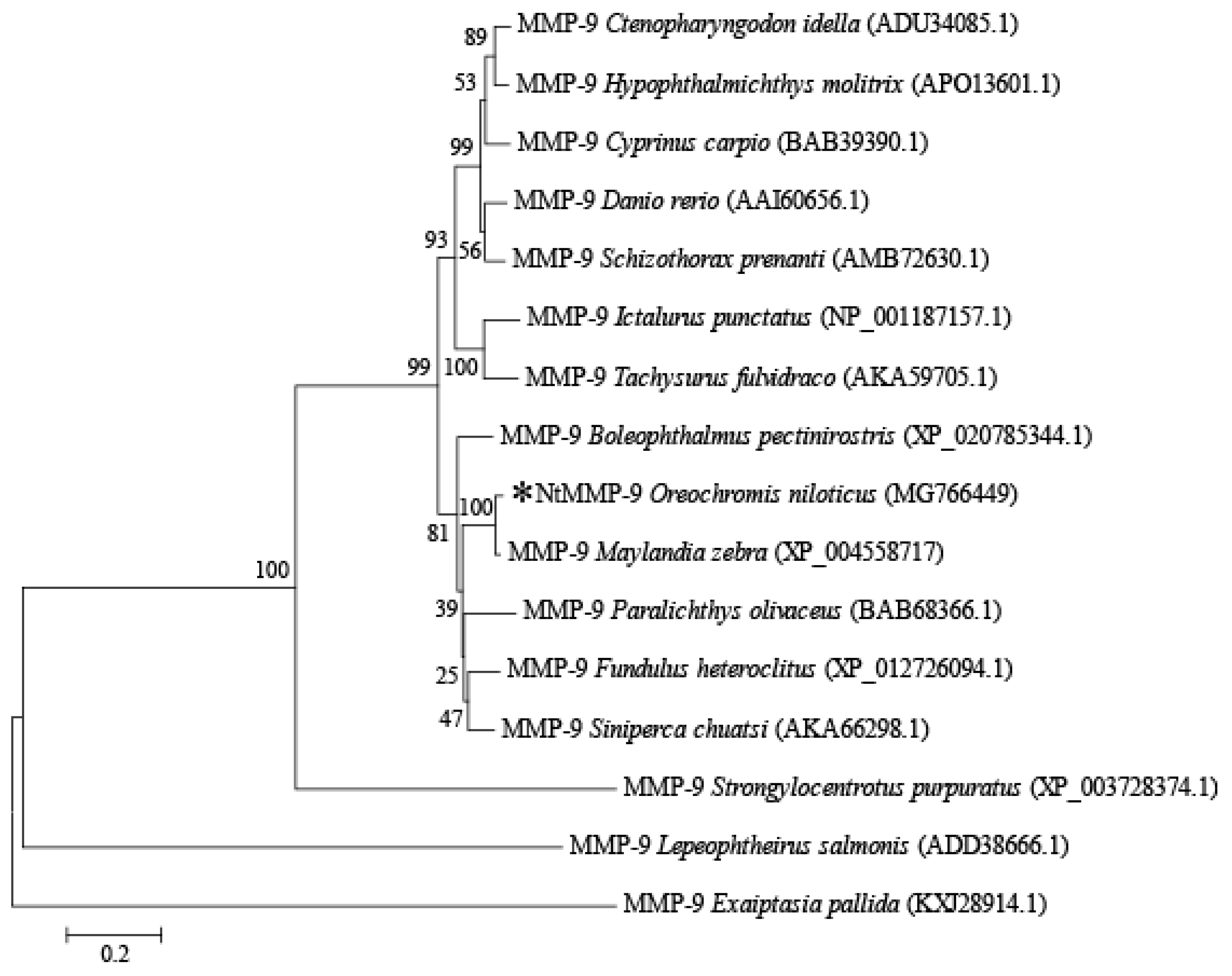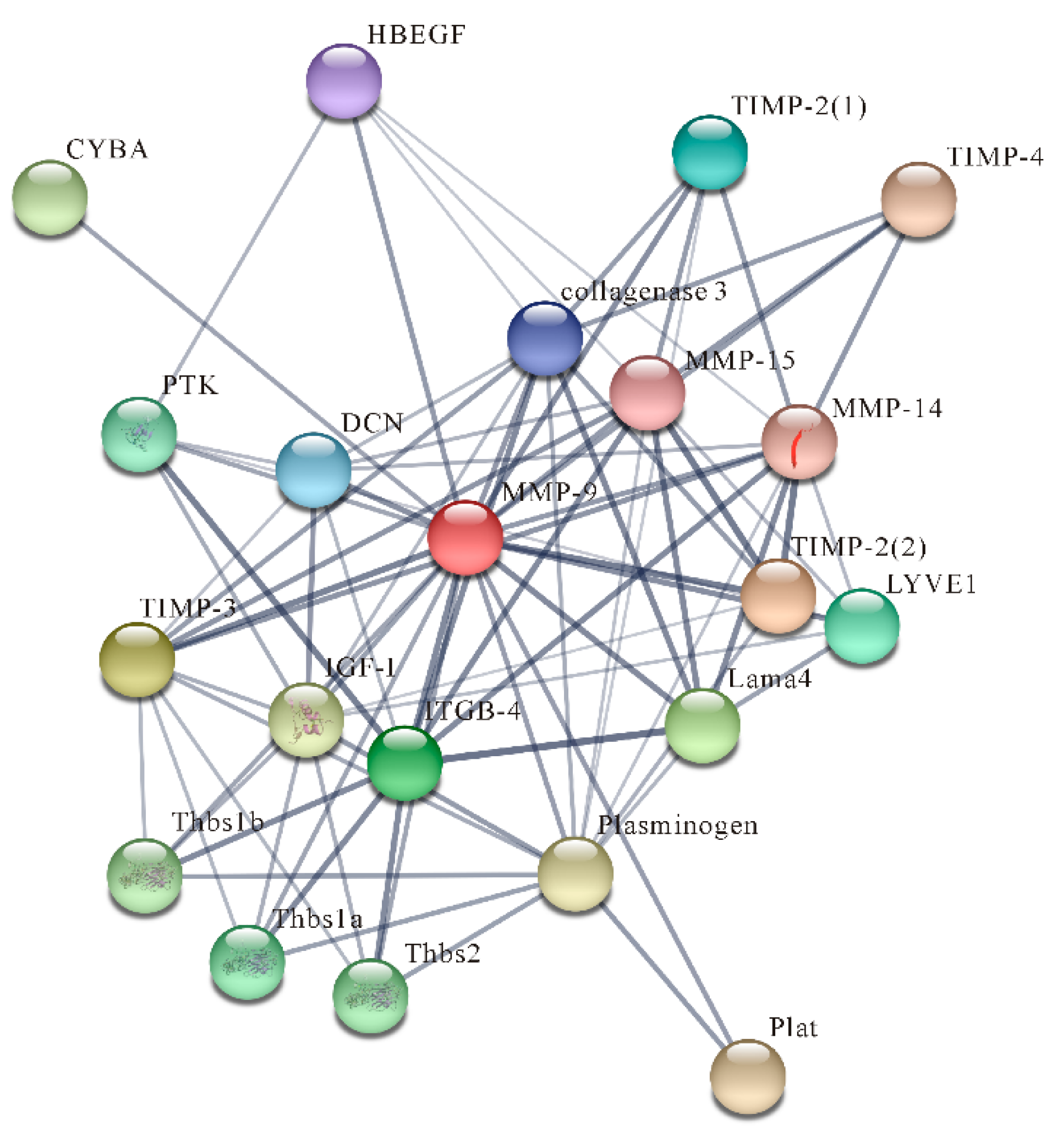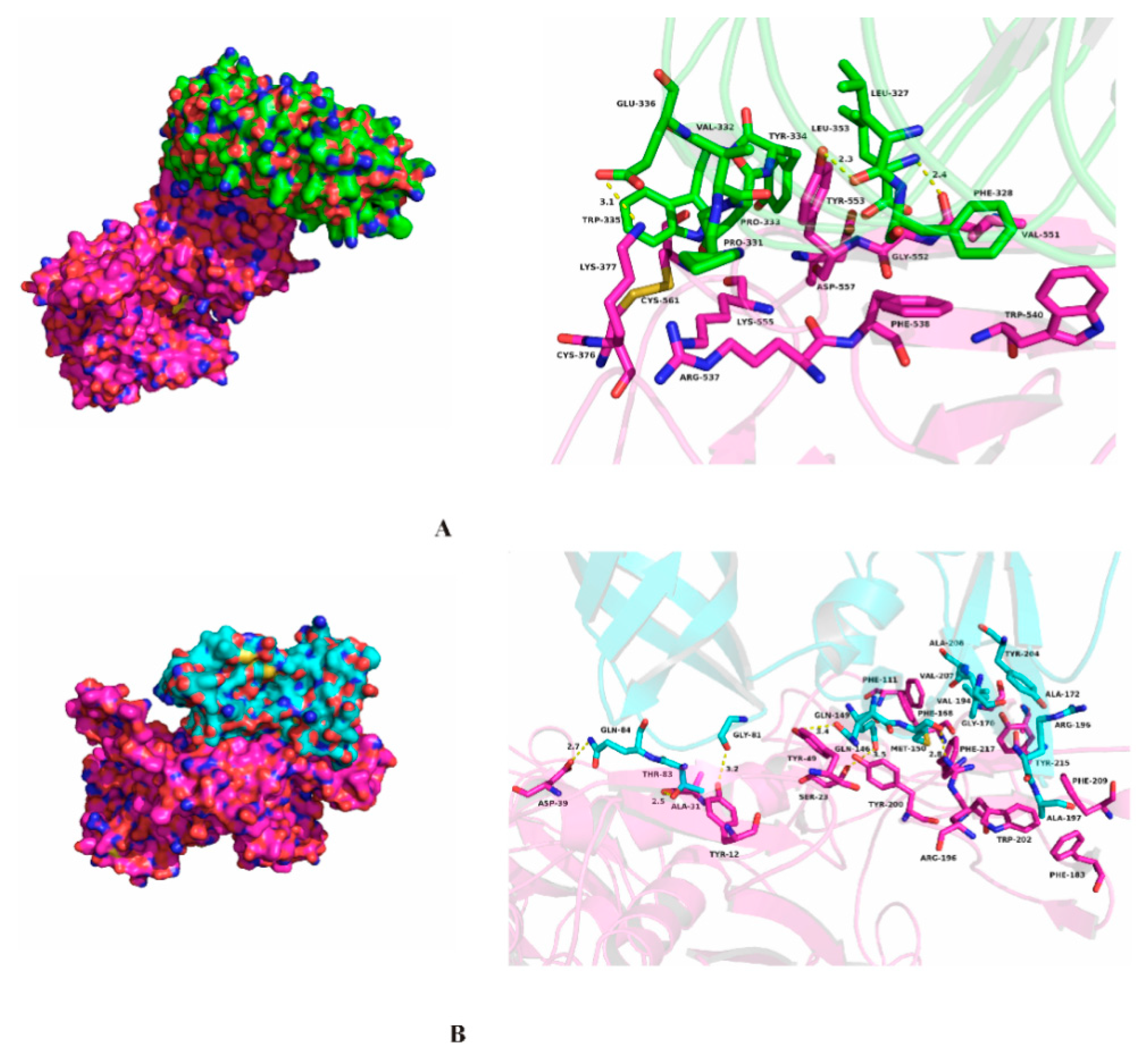Characterization of Matrix Metalloprotease-9 Gene from Nile tilapia (Oreochromis niloticus) and Its High-Level Expression Induced by the Streptococcus agalactiae Challenge
Abstract
1. Introduction
2. Materials and Methods
2.1. Fish Cultivation and Pathogen-Free Validation
2.2. RNA Extraction and NtMMP-9 Cloning
2.3. Bioinformatic Analysis of NtMMP-9
2.4. Challenge Experiment with S. agalactiae
2.5. qPCR Analysis of NtMMP-9 under the S. agalactiae Challenge
2.6. Heterologous Expression of NtMMP-9
2.7. Protease Activity Assay
2.8. Statistical Analysis
3. Results and Discussion
3.1. Cloning and Characterization of NtMMP-9
3.2. Alignment and Phylogenetic Analysis
3.3. Protein–Protein Interactions and Molecular Docking
3.4. Transcriptional Expression of NtMMP-9
3.5. Heterologous Expression and the Enzyme Activity of NtMMP-9
4. Conclusions
Supplementary Materials
Author Contributions
Funding
Acknowledgments
Conflicts of Interest
References
- Bruschi, F.; Pinto, B. Matrix metalloproteinases in parasitic infections. In Pathophysiological Aspects of Proteases; Chakraborti, S., Dhalla, N., Eds.; Springer: Singapore, 2017; Volume 14, pp. 321–352. [Google Scholar]
- Kukreja, M.; Shiryaev, S.A.; Cieplak, P.; Muranaka, N.; Routenberg, D.A.; Chernov, A.V.; Kumar, S.; Remacle, A.G.; Smith, J.W.; Kozlov, I.A.; et al. High-throughput multiplexed peptide-centric profiling illustrates both substrate cleavage redundancy and specificity in the MMP family. Chem. Biol. 2015, 22, 1122–1133. [Google Scholar] [CrossRef] [PubMed]
- Cancemi, P.; Falco, F.D.; Feo, S.; Arizza, V.; Vizzini, A. The gelatinase MMP-9like is involved in regulation of LPS inflammatory response in Ciona robusta. Fish. Shellfish Immunol. 2019, 86, 213–222. [Google Scholar] [CrossRef] [PubMed]
- Ke, F.; Wang, Y.; Hong, J.; Xu, C.; Chen, H.; Zhou, S.B. Characterization of MMP-9 gene from a normalized cDNA library of kidney tissue of yellow catfish (Pelteobagrus fulvidraco). Fish. Shellfish Immunol. 2015, 45, 260–267. [Google Scholar] [CrossRef] [PubMed]
- Lian, Y.Y.; He, H.H.; Zhang, C.Z.; Li, X.C.; Chen, Y.H. Functional characterization of a matrix metalloproteinase 2 gene in Litopenaeus vannamei. Fish. Shellfish Immunol. 2019, 84, 404–413. [Google Scholar] [CrossRef] [PubMed]
- Lachowski, D.; Cortes, E.; Rice, A.; Pinato, D.; Rombouts, K.; del Rio Hernandez, A. Matrix stiffness modulates the activity of MMP-9 and TIMP-1 in hepatic stellate cells to perpetuate fibrosis. Sci. Rep. 2019, 9, 7299. [Google Scholar] [CrossRef] [PubMed]
- McMillan, S.J.; Kearley, J.; Campbell, J.D.; Zhu, X.W.; Larbi, K.Y.; Shipley, J.M.; Senior, R.M.; Nourshargh., S.; Lloyd, C.M. Matrix metalloproteinase-9 deficiency results in enhanced allergen-induced airway inflammation. J. Immunol. 2004, 172, 2586–2594. [Google Scholar] [CrossRef]
- Opdenakker, G.; Proost, P.; Van Damme, J. Microbiomic and posttranslational modifications as preludes to autoimmune diseases. Trends Mol. Med. 2016, 22, 746–757. [Google Scholar] [CrossRef]
- Furuzawa-Carballeda, J.; Boon, L.; Torres-Villalobos, G.; Romero-Hernandez, F.; Ugarte-Berzal, E.; Martens, E.; Vandooren, J.; Rybakin, V.; Coss-Adame, E.; Valdovinos, M.; et al. Gelatinase B/Matrix Metalloproteinase-9 as Innate Immune Effector Molecule in Achalasia. Clin. Transl. Gastroen. 2018, 9, 208. [Google Scholar] [CrossRef]
- Aguayo, F.I.; Pacheco, A.A.; García-Rojo, G.J.; Pizarro-Bauerle, J.A.; Doberti, A.V.; Tejos, M.; García-Pérez, M.A.; Rojas, P.S.; Fiedler, J.L. Matrix metalloproteinase 9 displays a particular time response to acute stress: Variation in its levels and activity distribution in rat hippocampus. ACS Chem. Neurosci. 2018, 9, 945–956. [Google Scholar] [CrossRef]
- Volkman, H.E.; Pozos, T.C.; Zheng, J.; Davis, J.M.; Rawls, J.F.; Ramakrishnan, L. Tuberculous granuloma induction via interaction of a bacterial secreted protein with host epithelium. Science 2010, 327, 466–469. [Google Scholar] [CrossRef]
- Shan, Y.; Zhang, Y.; Zhuo, X.; Li, X.; Peng, J.; Fang, W. Matrix metalloproteinase-9 plays a role in protecting zebrafish from lethal infection with Listeria monocytogenes by enhancing macrophage migration. Fish. Shellfish Immunol. 2016, 54, 179–187. [Google Scholar] [CrossRef] [PubMed]
- Xu, X.Y.; Shen, Y.B.; Fu, J.J.; Liu, F.; Guo, S.Z.; Li, J.L. Characterization of MMP-9 gene from grass carp (Ctenopharyngodon idella): An Aeromonas hydrophila-inducible factor in grass carp immune system. Fish. Shellfish Immunol. 2013, 35, 801–807. [Google Scholar] [CrossRef] [PubMed]
- Yeh, H.Y.; Klesius, P.H. Complete structure, genomic organization, and expression of channel catfish (Ictalurus punctatus, Rafinesque 1818) matrix metalloproteinase-9 gene. Biosci. Biotechnol. Biochem. 2008, 72, 702–714. [Google Scholar] [CrossRef] [PubMed]
- Wang, B.; Gan, Z.; Cai, S.; Wang, Z.; Yu, D.; Lin, Z.; Lu, Y.; Wu, Z.; Jian, J. Comprehensive identification and profiling of Nile tilapia (Oreochromis niloticus) microRNAs response to Streptococcus agalactiae infection through high-throughput sequencing. Fish. Shellfish Immunol. 2016, 54, 93–106. [Google Scholar] [CrossRef]
- Liang, F.R.; Hong, Y.H.; Ye, C.C.; Deng, H.; Yuan, J.P.; Hao, Y.F.; Wang, J.H. Molecular characterization and gene expression of cathepsin L in Nile tilapia (Oreochromis niloticus). Fish. Shellfish Immunol. 2017, 67, 280–292. [Google Scholar] [CrossRef]
- Zhang, Z.; Yu, A.; Lan, J.; Zhang, H.; Hu, M.; Cheng, J.; Zhao, L.; Lin, L.; Wei, S. GapA, a potential vaccine candidate antigen against Streptococcus agalactiae in Nile tilapia (Oreochromis niloticus). Fish. Shellfish Immunol. 2017, 63, 255–260. [Google Scholar] [CrossRef]
- Brum, A.; Pereira, S.A.; Owatari, M.S.; Chagas, E.C.; Chaves, F.C.M.; Mouriño, J.L.P.; Martins, M.L. Effect of dietary essential oils of clove basil and ginger on Nile tilapia (Oreochromis niloticus) following challenge with Streptococcus agalactiae. Aquaculture 2017, 468, 235–243. [Google Scholar] [CrossRef]
- Zhu, J.; Fu, Q.; Ao, Q.; Tan, Y.; Luo, Y.; Jiang, H.; Li, C.; Gan, X. Transcriptomic profiling analysis of tilapia (Oreochromis niloticus) following Streptococcus agalactiae challenge. Fish. Shellfish Immunol. 2017, 62, 202–212. [Google Scholar] [CrossRef]
- Huang, L.Y.; Wang, K.Y.; Xiao, D.; Chen, D.F.; Geng, Y.; Wang, J.; He, Y.; Wang, E.L.; Huang, J.L.; Xiao, G.Y. Safety and immunogenicity of an oral DNA vaccine encoding Sip of Streptococcus agalactiae from Nile tilapia Oreochromis niloticus delivered by live attenuated Salmonella typhimurium. Fish. Shellfish Immunol. 2014, 38, 34–41. [Google Scholar] [CrossRef]
- Yi, T.; Li, Y.W.; Liu, L.; Xiao, X.X.; Li, A.X. Protection of Nile tilapia (Oreochromis niloticus L.) against Streptococcus agalactiae following immunization with recombinant FbsA and α-enolase. Aquaculture 2014, 428, 35–40. [Google Scholar] [CrossRef]
- Cheng, Y.Y.; Tao, W.J.; Chen, J.L.; Sun, L.N.; Zhou, L.Y.; Song, Q.; Wang, D.S. Genome-wide identification, evolution and expression analysis of nuclear receptor superfamily in Nile tilapia, Oreochromis niloticus. Gene 2015, 569, 141–152. [Google Scholar] [CrossRef] [PubMed]
- Liang, F.R.; He, H.S.; Zhang, C.W.; Xu, X.M.; Zeng, Z.P.; Yuan, J.P.; Hong, Y.H.; Wang, J.H. Molecular cloning and functional characterization of cathepsin B from Nile tilapia (Oreochromis niloticus). Int. J. Biol. Macromol. 2018, 116, 71–83. [Google Scholar] [CrossRef] [PubMed]
- Yang, C.G.; Wang, X.L.; Tian, J.; Liu, W.; Wu, F.; Jiang, M.; Wen, H. Evaluation of reference genes for quantitative real-time RT-PCR analysis of gene expression in Nile tilapia (Oreochromis niloticus). Gene 2013, 527, 183–192. [Google Scholar] [CrossRef] [PubMed]
- Jin, Y.L.; Jia, K.T.; Zhang, W.W.; Xiang, Y.X.; Jia, P.; Liu, W.; Yi, M.S. Zebrafish TRIM25 Promotes Innate Immune Response to RGNNV Infection by Targeting 2CARD and RD regions of RIG-I for K63-Linked Ubiquitination. Front. Immunol. 2019, 10, 2805. [Google Scholar] [CrossRef]
- Nguyen, H.; Park, J.; Park, S.; Lee, C.S. Long-term stability and integrity of plasmid-based DNA data storage. Polymers 2018, 10, 28. [Google Scholar] [CrossRef]
- Li, Q.; Ao, J.; Mu, Y.; Yang, Z.; Li, T.; Zhang, X.; Chen, X. Cathepsin S, but not cathepsin L, participates in the MHC class II-associated invariant chain processing in large yellow croaker (Larimichthys crocea). Fish. Shellfish Immunol. 2015, 47, 743–750. [Google Scholar] [CrossRef]
- Maciejczyk, M.; Pietrzykowska, A.; Zalewska, A.; Knaś, M.; Daniszewska, I. The significance of matrix metalloproteinases in oral diseases. Adv. Clin. Exp. Med. 2016, 25, 383–390. [Google Scholar] [CrossRef]
- Boon, L.; Ugarte-Berzal, E.; Vandooren, J.; Opdenakker, G. Glycosylation of matrix metalloproteases and tissue inhibitors: Present state, challenges and opportunities. Biochem. J. 2016, 473, 1471–1482. [Google Scholar] [CrossRef]
- Zouein, F.A.; DeCoux, A.; Tian, Y.; White, J.A.; Jin, Y.F.; Lindsey, M.L. Matrix metalloproteinase 9 (MMP-9). In Cardiac Fibrosis and Heart Failure: Cause or Effect? Dixon, I., Wigle, J., Eds.; Springer: Cham, Switzerland, 2015; Volume 13, pp. 237–259. [Google Scholar]
- Fischer, T.; Riedl, R. Inhibitory Antibodies Designed for Matrix Metalloproteinase Modulation. Molecules 2019, 24, 2265. [Google Scholar] [CrossRef]
- Ugarte-Berzal, E.; Vandooren, J.; Bailón, E.; Opdenakker, G.; García-Pardo, A. Inhibition of MMP-9-dependent degradation of gelatin, but not other MMP-9 substrates, by the MMP-9 hemopexin domain blades 1 and 4. J. Biol. Chem. 2016, 291, 11751–11760. [Google Scholar] [CrossRef]
- Chadzinska, M.; Baginski, P.; Kolaczkowska, E.; Savelkoul, H.F.J.; Kemenade, B.M.L.V. Expression profiles of matrix metalloproteinase 9 in teleost fish provide evidence for its active role in initiation and resolution of inflammation. Immunology 2008, 125, 601–610. [Google Scholar] [CrossRef] [PubMed]
- Walter, L.; Garg, P. Epithelial derived-matrix metalloproteinase (MMP9) has a defensive role in inflammation associated colorectal cancer by activating MMP9-ARF-p53 axis. Inflamm. Bowel. Dis. 2016, 22, S59. [Google Scholar] [CrossRef][Green Version]
- Ashok, A.; Rai, N.K.; Raza, W.; Pandey, R.; Bandyopadhyay, S. Chronic cerebral hypoperfusion-induced impairment of Aβ clearance requires HB-EGF-dependent sequential activation of HIF1α and MMP9. Neurobiol. Dis. 2016, 95, 179–193. [Google Scholar] [CrossRef]
- Merline, R.; Moreth, K.; Beckmann, J.; Nastase, M.V.; Zeng-Brouwers, J.; Tralhão, J.G.; Lemarchand, P.; Pfeilschifter, J.; Schaefer, R.M.; Iozzo, R.V.; et al. Signaling by the matrix proteoglycan decorin controls inflammation and cancer through PDCD4 and microRNA-21. Sci. Signal. 2011, 4, 75–90. [Google Scholar] [CrossRef] [PubMed]
- Ueda, K.; Yoshimura, K.; Yamashita, O.; Harada, T.; Morikage, N.; Hamano, K. Possible dual role of decorin in abdominal aortic aneurysm. PLoS ONE 2015, 10, e0120689. [Google Scholar] [CrossRef] [PubMed]
- Gan, Z.; Chen, S.N.; Hou, J.; Huo, H.J.; Zhang, X.L.; Ruan, B.; Laghari, Z.A.; Li, L.; Lu, Y.S.; Nie, P. Molecular and functional characterization of peptidoglycan-recognition protein SC2 (PGRP-SC2) from Nile tilapia (Oreochromis niloticus) involved in the immune response to Streptococcus agalactiae. Fish. Shellfish Immunol. 2016, 54, 1–10. [Google Scholar] [CrossRef]
- Liu, L.; Li, Y.W.; He, R.Z.; Xiao, X.X.; Zhang, X.; Su, Y.L.; Wang, J.; Li, A.X. Outbreak of Streptococcus agalactiae infection in barcoo grunter, Scortum barcoo (Mc Culloch & Waite), in an intensive fish farm in China. J. Fish. Dis. 2014, 37, 1067–1072. [Google Scholar]
- Kaminari, A.; Giannakas, N.; Tzinia, A.; Tsilibary, E.C. Overexpression of matrix metalloproteinase-9 (MMP-9) rescues insulin-mediated impairment in the 5XFAD model of Alzheimer’s disease. Sci. Rep. 2017, 7, 683. [Google Scholar] [CrossRef]
- Samuel, R.V.M.; Farrukh, S.Y.; Rehmat, S.; Hanif, M.U.; Ahmed, S.S.; Musharraf, S.G.; Durrani, F.G.; Saleem, M.; Gul, R. Soluble production of human recombinant VEGF-A121 by using SUMO fusion technology in Escherichia coli. Mol. Biotechnol. 2018, 60, 585–594. [Google Scholar] [CrossRef]
- Tajhya, R.B.; Patel, R.S.; Beeton, C. Detection of matrix metalloproteinases by zymography. In Matrix Metalloproteases; Humana Press: New York, NY, USA, 2017; pp. 231–244. [Google Scholar]
- McClellan, S.A.; Huang, X.; Barrett, R.P.; Lighvani, S.; Zhang, Y.; Richiert, D.; Hazlett, L.D. Matrix metalloproteinase-9 amplifies the immune response to Pseudomonas aeruginosa corneal infection. Investig. Ophthalmol. Vis. Sci. 2006, 47, 256–264. [Google Scholar] [CrossRef]
- Tomlin, H.; Piccinini, A.M. A complex interplay between the extracellular matrix and the innate immune response to microbial pathogens. Immunology 2018, 155, 186–201. [Google Scholar] [CrossRef] [PubMed]
- Ezhov, M.; Safarova, M.; Afanasieva, O.; Mitroshkin, M.; Matchin, Y.; Pokrovsky, S. Matrix Metalloproteinase 9 as a Predictor of Coronary Atherosclerotic Plaque Instability in Stable Coronary Heart Disease Patients with Elevated Lipoprotein (a) Levels. Biomolecules 2019, 9, 129. [Google Scholar] [CrossRef] [PubMed]





| Primer | Sequence (5′–3′) |
|---|---|
| NMP9-F1 | GTGCCGCGCGGCAGCCATATGAGATGCTGTACTTTACTTGTG |
| NMP9-R1 | AAGGAGTATCACTCATGCACAAG |
| NMP9-F2 | GTATCACTCATGCACAAGCGAG |
| NMP9-R2 | CTCAAGTGCTCATCAGACACCCGCTACTGACTCGAGCACCACCA |
| qNMP9-F | ATGCTTTTGCCAGAGCGTTT |
| qNMP9-R | TGTCAGCCGTGCCGTCA |
| yNMP9-F | CATATGGGCGATCTGAAATGGGATC (the underlined bases encode Nde I) |
| yNMP9-R | CTCGAGTTAATAGCGTGTATCGCTTGA (the underlined bases encode Xho 1) |
© 2020 by the authors. Licensee MDPI, Basel, Switzerland. This article is an open access article distributed under the terms and conditions of the Creative Commons Attribution (CC BY) license (http://creativecommons.org/licenses/by/4.0/).
Share and Cite
Liang, F.-R.; Wang, Q.-Q.; Jiang, Y.-L.; Yue, B.-Y.; Zhou, Q.-Z.; Wang, J.-H. Characterization of Matrix Metalloprotease-9 Gene from Nile tilapia (Oreochromis niloticus) and Its High-Level Expression Induced by the Streptococcus agalactiae Challenge. Biomolecules 2020, 10, 76. https://doi.org/10.3390/biom10010076
Liang F-R, Wang Q-Q, Jiang Y-L, Yue B-Y, Zhou Q-Z, Wang J-H. Characterization of Matrix Metalloprotease-9 Gene from Nile tilapia (Oreochromis niloticus) and Its High-Level Expression Induced by the Streptococcus agalactiae Challenge. Biomolecules. 2020; 10(1):76. https://doi.org/10.3390/biom10010076
Chicago/Turabian StyleLiang, Fu-Rui, Qin-Qing Wang, Yun-Lin Jiang, Bei-Ying Yue, Qian-Zhi Zhou, and Jiang-Hai Wang. 2020. "Characterization of Matrix Metalloprotease-9 Gene from Nile tilapia (Oreochromis niloticus) and Its High-Level Expression Induced by the Streptococcus agalactiae Challenge" Biomolecules 10, no. 1: 76. https://doi.org/10.3390/biom10010076
APA StyleLiang, F.-R., Wang, Q.-Q., Jiang, Y.-L., Yue, B.-Y., Zhou, Q.-Z., & Wang, J.-H. (2020). Characterization of Matrix Metalloprotease-9 Gene from Nile tilapia (Oreochromis niloticus) and Its High-Level Expression Induced by the Streptococcus agalactiae Challenge. Biomolecules, 10(1), 76. https://doi.org/10.3390/biom10010076





